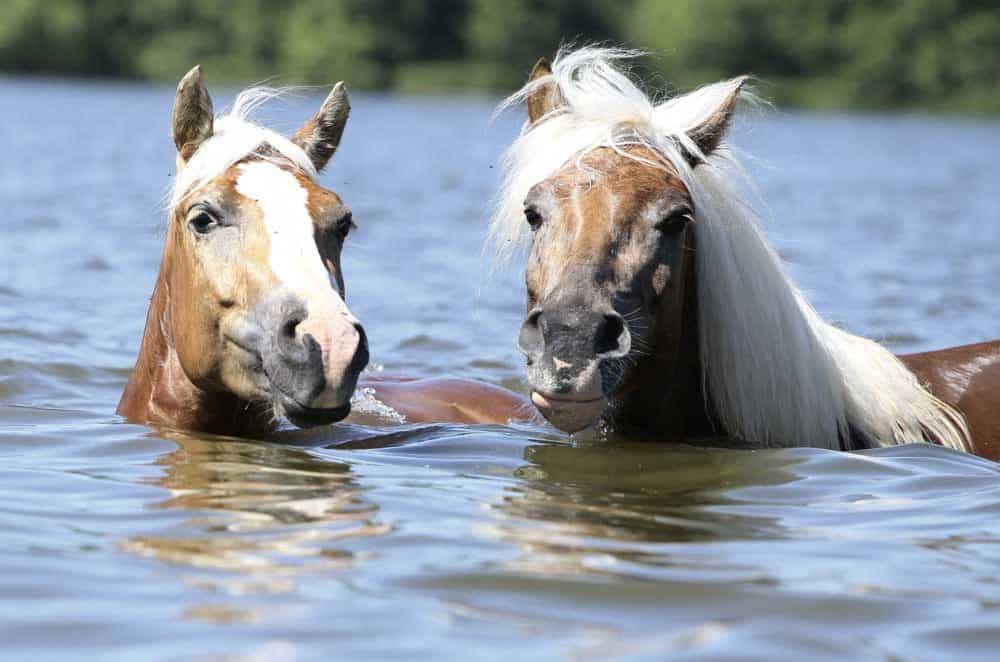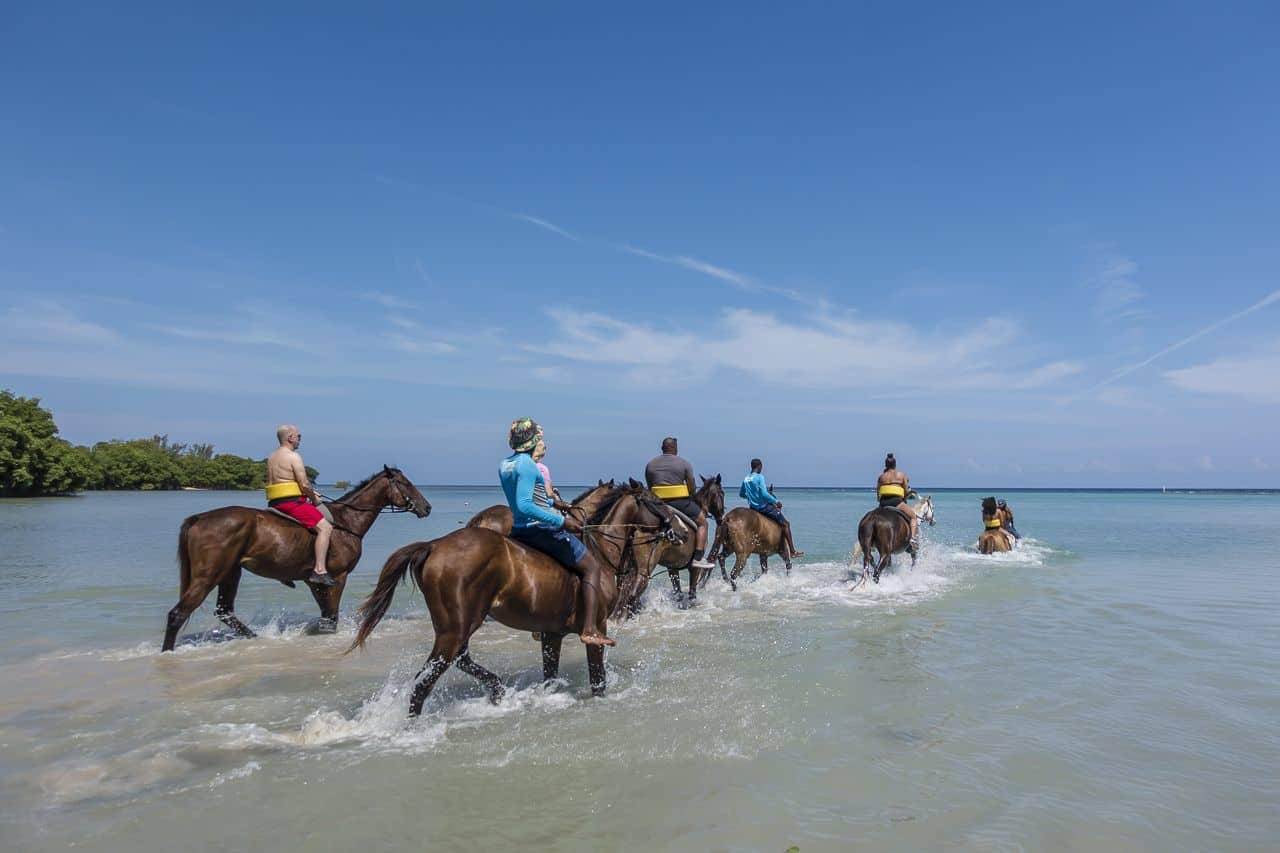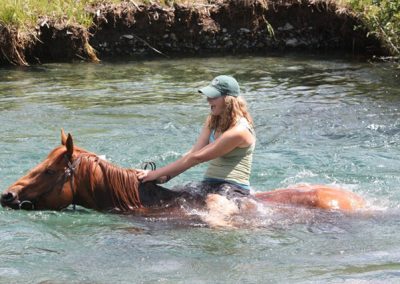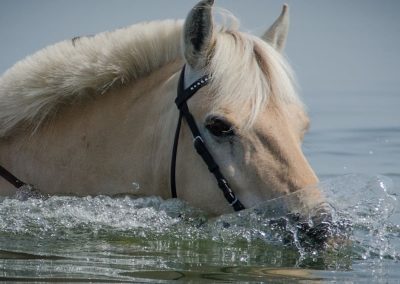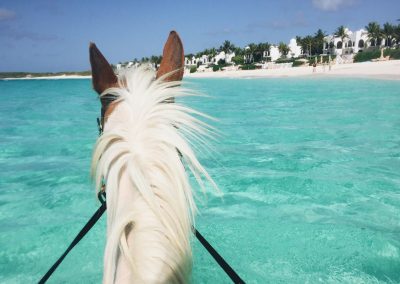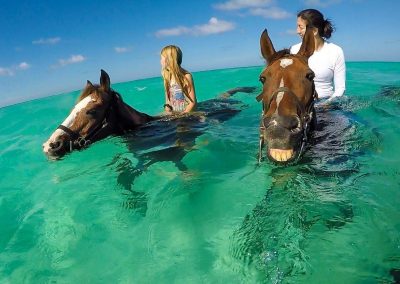Table of Contents
Can Horses Swim? All you need to know about horses swimming
Can horses swim? The answer to this question depends on the breed of horse. Some animals are good swimmers, while others do not enjoy the activity. Aside from swimming in the lake, a horse also needs to swim to prevent exhaustion. Some horses have trouble in the water, while others can do it without too much effort. It is important to know your horse’s limitations before venturing into deep water. The following are some tips to keep your horse happy and safe when swimming.
First, start by gradually introducing your horse to the water. While horses can’t hold their breath while submerged, they can learn to swim by being immersed in shallow water for short periods of time. As long as your horse can float, he won’t panic. Once your horse is comfortable with the water, you can gradually introduce him to deeper areas. Eventually, you’ll be able to introduce him to deeper waters for longer periods.
Once the horse’s hooves no longer touch the ground, he can start swimming. His huge lungs and air-filled fiber contribute to keeping him afloat. Although swimming horses can’t swim far, it is worth a try. Remember to be careful and limit the time spent in the water, as they don’t have the ability to see the bottom of the ocean. However, you should be aware that there’s a safe swimming time limit for a horse.
The first step is to let your horse swim in shallow water. Once you are sure of your horse’s buoyancy, you can slowly move it to knee-deep water or full-body water. You should never drag the horse as the rider’s weight will increase the risk of drowning. When you first start swimming with your horse, it’s a good idea to remove the saddle before you take it into the water.
If you are a horse owner, you’ll want to know that horses can swim. A horse’s swim training is an important part of training. If your horse is not afraid of water, he will eventually lose his fear. Initially, you’ll want to keep the duration of the swim at ten minutes or less. If your horse is still scared of the water, you should try it in a small pool first.
When you begin training your horse to swim, you must be prepared to bathe him. Initially, your horse will need to be bathed before he can learn to swim. Eventually, he will become more confident in the water. It’s important to use proper safety equipment and techniques when he’s in the water. It is important to be patient and do not rush the training. A swimming horse will not like to be in the water without the right instruction.
In addition to being nervous, horses are not able to hold their breath like humans do. Using a swim pad is the best way to train them for this activity. You can also try to swim bareback and without a saddle. This will help you avoid the risk of drowning. You should watch out for your horse’s legs. You may accidentally float off of the horse’s back if you aren’t prepared.
You should never try to force your horse to swim. You should always remain afloat at all times. Even if you have a strong horse, he won’t like getting wet. It will also be traumatic for your horse. He should not be forced to voluntarily go underwater. You must ensure that he is comfortable in the water. You can train your horse to float while you swim.
When it comes to swimming, keep in mind that horses are not suited for ocean conditions. They can’t withstand big waves, and their breath isn’t strong enough to hold it underwater. While they can swim in calm water, they don’t float in the open water. In addition to being unfit, they can also be injured if they have too much stress or a lot of work.
If you have a horse that can swim, you should make sure it has a rest day in between sessions. A rest day is essential to keep your horse in shape and prevent injury. A horse can only swim for about five to seven minutes before it becomes exhausted. When it needs a rest, it should be given a break for at least two minutes every 10 minutes. This will allow you to build up the duration of the sessions until you reach the level of comfort for your horse.
Can horses swim with a rider?
Can horses swim with a rider? You can, but first you need to know what you’re doing. A horse can float on the surface of the water but won’t be able to swim in deeper water. It can’t float on top of the water. You’ll need to keep a safe distance from the animal and adjust your technique. If you can’t manage this, your horse may become stressed and panicky.
You can swim with your horse, but you’ll need to be prepared. The first thing you need to do is make sure you have the right equipment. A helmet is not the right choice. Another important part of your safety gear is a life jacket. Also, make sure you know where you’ll be going. If you have a horse, it is essential that you’re wearing the correct clothing. You’ll also need to have the appropriate insurance for your horse.
Can horses swim with a rider? You can ride a horse while swimming. If you’re not sure if your horse can swim, you can hold on to its mane. However, don’t try to pull or push it. If your horse is not used to the water, they’ll want to kick forward. While it’s safe, it’s important to remember that you shouldn’t put pressure on them.
How do horses swim?
While you’d probably love to ride a horse that loves to splash about in the water, he probably isn’t as excited as you are about the idea. Wild horses have to cross rivers to access food and safety. While domesticated horses are naturally friendly, they aren’t trained to swim, so they may have a difficult time swimming in a pool. However, don’t let that stop you from trying. Here are some helpful tips for training your horse to swim.
First, horses have been using swimming for thousands of years for many purposes. They’ve used it for food search and to avoid danger. As a result, they’re natural swimmers. In fact, many species of animals have been swimming for thousands of years, including human species. The equine instinct helps them navigate the world. If you’d like to train your horse to swim, you’ll need to understand how they think.
You can start by watching a video of a horse swimming. This will give you an idea of what he does while in the water. You should keep your body away from the horse’s head, and try to stay on the shoreline. Make sure to stand far enough forward to prevent the horse from unexpectedly kicking out. If your horse has a strong tail, he’ll have a harder time staying under the water.
What are the benefits of horses swimming?
Horses that swim regularly reap the same physical and mental benefits as people. Not only does it increase the heart rate, but it strengthens bones. It also improves the horse’s fitness level. It reduces aches and pains. Training on hard surfaces is difficult on horses. Adding swimming to your horse’s exercise program can improve their overall health and fitness. Not only will they enjoy the water, but they will be less likely to get hurt.
Among the many benefits of swimming for horses is the fact that it improves the cardiovascular and respiratory systems. It builds a healthy heart and lungs and complements the respiratory system. The latter is essential in acquiring oxygen, so an effective cardio exercise is an important part of a horse’s training routine. In addition, it reduces the chances of a horse suffering from limb injuries. A healthy heart and lungs increase a horse’s stamina, which are important for peak performance.
The physical benefits of swimming for horses are numerous. The main perceived benefit of this activity is that it requires less musculoskeletal stress. However, the study of animals has shown that it can contribute to a horse’s conditioning and rehabilitation. A lack of objective data has made the conclusion that swimming is not a good choice for all cases. Nonetheless, it can be a valuable part of a horse’s training regimen.
Horses have similar body structures. They engage all body systems, including their limbs, so they don’t experience muscular strain or fatigue when exercising. As a result, swimming can help the horse recover from injury more quickly. Furthermore, the physical benefits of swimming for horses include improved flexibility and strength. Although swimming for horses isn’t a substitute for a good workout on land, it can be an excellent complement to a healthy one.
Besides helping the horse recover from injuries, swimming for horses can help maintain mental and physical health. It also improves muscle tone. It can help improve general fitness. If the horse has a history of bleeding from the lungs, it may find it difficult to swim in water. Another reason for swimming for horses is that it can prevent muscular contractions. It is an aerobic activity that will allow the horse to stretch fully.
Besides being a great way to exercise, swimming also helps horses recover from injury. It improves muscle tone and makes the horse mentally calm. Injuries to the tendons can also be treated with a course of swimming. As a result, there is less risk of re-injury. The horse will feel more flexible and relaxed after a swim session. It will be less likely to be prone to injuries.
How fast can a horse swim?
The evolution of the horse began as a small, multiple-toed creature, Eohippus, and evolved into the large, single-toed animal we know today. Today, the horse belongs to the family Equus and is one of two extant subspecies of the genus Equus. The fastest a horse can swim depends on its breed and size. There are three types of horses: Arabian, quarter horse, and TB.
Swimming is physically and mentally tiring for horses. They must start slow and work their way up to full body water. Try swimming in shallow water first, and then move to knee-deep or even deeper. It is important to stay near shore and avoid entanglements and obstructions in the water. This will ensure that the horse does not get trapped in deep water or become exhausted. When a horse starts to breathe heavily, bring them back to shore and let them rest for a while.
While a horse can swim for long periods in calm water, its open water swimming abilities are harder to predict. During the training process, the horse spent the majority of its energy propelling itself forward, and this requires a lot of energy. Salt water is a much higher density than fresh water, so horses are able to float better and longer. It is important to remember that the distance covered is only a guideline.
Are horses afraid of water
Are horses afraid of water? Most of the time, yes. Many of them do not like the feeling of getting wet and roll around in the water vigorously to dry off. However, fear of the unknown under the surface of the water can also cause your horse to shy away from the water. Some of the most common fears of horses include noise from the ocean and the possibility of being stranded in a wet place.
Some horses don’t feel comfortable in the water at first, but it is possible to introduce them to it gradually and safely. Never jump them into the water without proper training. A few hours of playtime in the water can help the horse to overcome his or her fear. Besides, most horses are social and love to interact with other horses. This means that some of them will get used to water and will swim happily. But, what if your horse is afraid of the water?
A horse’s eyes are placed on the sides of its head and they are not able to distinguish detail in water. The eyes of a horse are prone to panic when it is in the water and a bad experience could make the horse even more fearful of it. If a horse has a bad experience with water, it will automatically associate it with negative things and therefore avoid swimming. Some horses may not like the feeling of getting wet, so it’s important to understand that they can learn to enjoy being wet.
As humans, horses can be fearful of water. Some horses love swimming, but others are phobic of water and can’t even get in the water. If you want to keep your horse safe, you must start with basic ground training. You must make sure that your horse trusts you and is comfortable in the water. If you’re not sure whether your horse is afraid of water, you can start by letting it go for a swim in your backyard.
Fortunately, there are many methods to help a horse overcome its fear of water. You can begin by slowly introducing your horse to water. Don’t force him into the water right away. He needs to be accustomed to the idea before he can accept it. And it’s important to remember that the most successful method is to be patient. Always remember that a horse’s fear of water can be overcomplicated and dangerous if it is not trained properly.
There are many factors that can make a horse afraid of water. One of the most obvious reasons is its ability to swim and its ability to feel safe. A horse’s natural instincts will allow him to swim on its own and will probably enjoy it as well. But if you don’t let him enter the water, there’s no need to worry. This is a good way to rehab a horse after an injury.
How Swimming Helps Horses with Injuries
Regardless of the kind of injury, your horse can benefit from swimming. A swimming pool provides a great cardiovascular workout for a horse, and it also calms its mind. Besides helping your horse get back to full health, swimming can also help horses recover from an injury. Learn how swimming helps horses with injuries. This article will explain how to swim safely with your horse. We’ve compiled some helpful tips below.
First, make sure your horse has the proper exercise for its particular injury. Swimming can improve the condition of tendons and muscles in a horse. Tendons are the tissues that connect the muscles to the bones. These tendons are like springs in the body and carry a great deal of weight. Because they carry so much weight, they are more prone to injury than any other part of the body. When you swim with your horse, the water will help it stay flexible and toned.
Another benefit of swimming for horses is that it’s a great way to treat tendon injuries. A horse’s tendons are made of fibrous tissue that attaches muscles to bones. Since they carry so much weight, they are more likely to get injured than any other part of the body. This means that it’s essential to prevent tendon injuries by getting your horse to swim. The water will help your horse maintain its muscle tone and flexibility.
Taking your horse swimming can help improve recovery from an injury. Unlike humans, horses can swim for long periods in calm, open water. They spend most of their energy pushing themselves forward. This can be beneficial because salt water is denser than fresh water, making it easier for them to float. Lastly, swimming is a good way to help your horse recover from a horse injury. But make sure you consult a veterinarian before starting an exercise program for your horse.
If you’re looking for ways to swim with your horse, you can consult a veterinarian before incorporating swimming into your routine. If you’re not sure whether or not swimming is a good idea, you’ll want to work with your veterinarian to ensure your horse’s safety. Remember that horses can sustain injuries in many different ways, and a proper diagnosis is important. The first step is to discuss the risks and benefits of the therapy with a veterinarian.
A horse swimming program should begin with a consultation with a veterinarian. Your veterinarian will determine if swimming is an appropriate exercise program for your horse. If your horse has an injury, he or she will advise you on whether it is safe. Always consult a veterinarian before beginning a swimming program. A thorough check-up will ensure that your horse is healthy and safe to swim. If you do decide to start, be sure to talk with your veterinarian.
Can horses swim underwater
Most horse lovers wonder if horses can swim underwater. This is not a simple question to answer. Although a horse has a large lung capacity, it cannot hold its breath underwater. In order to stay afloat, it must propel itself forward. It does this by mimicking its trotting motion. As a result, it appears as if it is paddling through water. Unlike people, however, horses do not drown. Instead, they use their big lungs as a floatation mechanism while submerged. During this time, they suspend their heads to avoid letting water enter their heads.
The first step in teaching your horse to swim underwater is to get it used to the water. You should always have another horse with you if you have to swim your horse. This way, you can take your weight off the first one and allow it to get used to the water. You can also try to start swimming in shallow water to acclimatize your horse to water. Once your horse has acclimatized to the water, you can move them to knee-deep water.
Despite being the largest land animal, horses are not built for ocean conditions. They can’t handle big waves and can’t hold their breath under water. While they can swim in calm water, they cannot survive in open water. A horse will be exhausted in less than 10 minutes compared to a human. It is important to remember that the water can be very cold when swimming, which makes it difficult for horses to breathe underwater.
Before attempting to swim your horse, you need to prepare it for this adventure by first getting it used to the water. Alternatively, you can have a second horse a little closer to shore and make it easier for your horse to cope. Regardless, it is essential to avoid causing them too much stress by forcing them to swim in deep water. Never leave a wet horse unsupervised in the water. If you have children nearby, it is important to keep them away from the wet horse so that they don’t have access to the nervous system.
In order to safely swim with your horse, you should ensure that he is comfortable with the water. The horse should be able to stay under water for about 30 minutes without tiring. While swimming, keep in mind that horses are not ocean animals. In fact, they don’t float. They swim for longer distances when it is calm. It is important to avoid dangerous conditions with your animal. If your horses are unable to stand under the water, they may become injured or even drown.
If you must swim your horse, you must begin by introducing it to the water slowly. In addition, you should never leave the horse alone in deep water, as it may panic. You should always have a second person nearby to supervise and rescue your horse. It is also vital to ensure the water is safe for your horse. If you do get into trouble, the only way you’ll survive is to be prepared to help your animal.
Risks for Swimming Horses
Among the many risks associated with swimming equines is the risk of falling off the horse. It is particularly dangerous when the horse is not trained for it and is used to being in a stable. While this may not seem as dangerous as a fall from a horse, it can cause severe injuries if the animal kicks underwater. Even if the kick happens while the horse is underwater, it can still injure the rider.
There are several risks associated with swimming horses. For one thing, horses are not adapted to ocean conditions. They are not able to stand big waves and can’t hold their breath under water. They may also be unable to float in open water. While it may be possible for you to take the horse to the water, it can be hazardous. This is because the horse’s body is not designed for swimming. Moreover, swimming in water might stress the horse and make him more susceptible to injuries.
For the same reason, you must also check the water’s depth, as waves can cause the horse to fall off the horse. Besides, big waves can be dangerous for your horse, as it can cause the animal’s energy levels to plummet. You should also make sure that the water’s surface is safe for swimming. There might be jellyfish, turtles, or even leeches that may pose a risk to your horse.
The first risk is that your horse will panic or get stressed out. You should stop the swimming session immediately if you notice that the eyes of your horse are wide. This might be a sign of stress, and your horse is not comfortable with the deep water. If you see your horse struggling to swim, stop the session. The second risk is that the water is too shallow and your horse might not be able to breath.
When swimming your horse, keep in mind that water conditions are not suitable for the animal. It is unlikely that your horse will be able to withstand big waves, and it will be impossible to maintain a steady position underwater. Besides, the water can also contain a variety of predators. The dangers associated with swimming horses can vary depending on the type of horse and the type of riding. You should always be careful not to fall off a horse.
The first risk for swimming your horse is drowning. Since horses cannot hold their breath like humans can, they are unable to hold their breath. Keeping your horse afloat is essential to prevent them from suffering any serious injuries. When swimming, be aware that your horse may not be able to hold its breath. If your horse becomes underwater, it will be difficult for you to control the situation. Your best option is to jump into the water and try to swim barefoot.
Horses Swimming Gallery
Horse Swimming FAQs
Below are some of the most common frequently asked questions regarding horse swimming.
Is it bad for horses to swim?
Horses can swim, and a number are quite proficient. … But it’s not too difficult for horses to swim because they have natural floatation devices inside their bodies, huge lungs. Swimming horses can be fun on a trail ride, but it also has therapeutic benefits.
Can horses hold their breath underwater?
Can Horses Breathe Under Water? Unlike humans, horses cannot hold their breath underwater. They can easily get stressed out if their head is under the water. So, if it’s windy in the ocean and there are big waves, it can be dangerous for your horse to swim, and the risk of getting drown is relatively high.
Can horses really swim?
Horses can swim, and a number are quite proficient. … But it’s not too difficult for horses to swim because they have natural floatation devices inside their bodies, huge lungs. Swimming horses can be fun on a trail ride, but it also has therapeutic benefits.
How long do you swim a horse?
As a guide – depending on whether swimming is used to replace or supplement track work or simply to refresh – most horses start with several straight laps (4-8 min) and increase to 8 min or more continuous laps in a circular pool 3-6 days per week within 6 weeks. Some do several 5-8 min sets with 1-3 min rest between.
How fast can a horse swim?
55 mph
Maximum, Sprint
Horse/Speed
Do horses like to swim in the ocean?
Horses have a natural instinct to swim when they hit deep water and readily perform a paddle like action, not too dis-similar from a trotting action. A horses’ natural ability is necessary as a means of survival.
Why is swimming good for horses?
Equine hydrotherapy: swimming
Swimming can be used to build fitness and stamina, improve muscle tone and can be helpful when a horse is recovering from an injury. One of the major benefits of swimming is the lack of concussion on the horse’s legs compared to fast work, like galloping.


